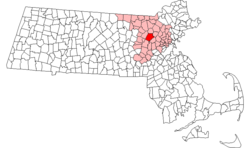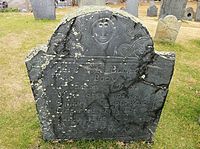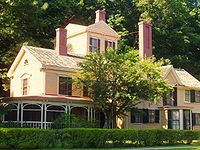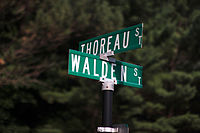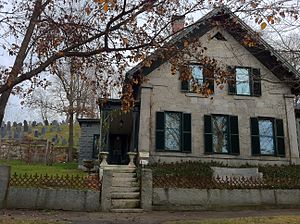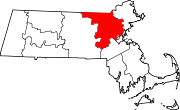- Concord, Massachusetts
-
Concord, Massachusetts — Town — View of Concord's Main Street in December 
SealLocation in Middlesex County in Massachusetts Coordinates: 42°27′37″N 71°20′58″W / 42.46028°N 71.34944°WCoordinates: 42°27′37″N 71°20′58″W / 42.46028°N 71.34944°W Country United States State Massachusetts County Middlesex Settled 1635 Incorporated 1635 Government - Type Open town meeting Area - Total 25.9 sq mi (67.4 km2) - Land 24.9 sq mi (64.5 km2) - Water 1.0 sq mi (2.5 km2) Elevation 141 ft (43 m) Population (2007) - Total 17,668 - Density 676.3/sq mi (261.1/km2) Time zone Eastern (UTC-5) - Summer (DST) Eastern (UTC-4) ZIP code 01742 Area code(s) 351 / 978 FIPS code 25-15060 GNIS feature ID 0619398 Website www.concordma.gov Concord is a town in Middlesex County, Massachusetts, in the United States. As of the 2010 census, the town population was 17,668. Although a small town, Concord is noted for its leading roles in American history and literature.
Contents
History
The area which became the Town of Concord was originally known as "Musketaquid", situated at the confluence of the Sudbury and Assabet rivers.[1] Native Americans had cultivated corn crops there; the rivers were rich with fish and the land was lush and arable.[2] However, the area was largely depopulated by the smallpox plague that swept across the Americas after the arrival of Europeans.[3] In 1635, a group of British settlers led by Rev. Peter Bulkley and Simon Willard negotiated a land purchase with the remnants of the local tribe; that six-square-mile purchase formed the basis of the new town, which was called "Concord" in appreciation of the peaceful acquisition.[1]
The Battle of Lexington and Concord was the initial conflict in the American Revolutionary War. On April 19, 1775, a force of British Army regulars marched from Boston to Concord (pausing for an early-morning skirmish at Lexington, where the first shots of the Battle were fired) to capture a cache of arms that was reportedly stored in the town. Forewarned of the British troop movements, colonists from Concord and surrounding towns repulsed a British detachment at the Old North Bridge and forced the British troops to retreat.[4] The battle was initially publicized by the colonists as an example of British brutality and aggression: one colonial broadside decried the "Bloody Butchery of the British Troops."[5] A century later, however, the conflict was remembered proudly by Americans, taking on a patriotic, almost mythic status in works like the "Concord Hymn" and "Paul Revere's Ride."[6] In April 1975, the town hosted a bicentennial celebration of the battle, featuring an address at the Old North Bridge by President Gerald Ford.[7]
Concord has a remarkably rich literary history centered in the mid-nineteenth century around Ralph Waldo Emerson (1803–1882), who moved to the town in 1835 and quickly became its most prominent citizen.[8] Emerson, a successful lecturer and philosopher, had deep roots in the town: his father Rev. William Emerson (1769–1811) grew up in Concord before becoming an eminent Boston minister, and his grandfather, William Emerson Sr., witnessed the battle at the North Bridge from his house, and later became a chaplain in the Continental Army.[9] Emerson was at the center of a group of like-minded Transcendentalists living in Concord.[10] Among them were the author Nathaniel Hawthorne (1804–1864) and the philosopher Bronson Alcott (1799–1888), the father of Louisa May Alcott (1832–1888). A native Concordian, Henry David Thoreau (1817–1862), was another notable member of Emerson's circle. This substantial collection of literary talent in one small town led Henry James to dub Concord "the biggest little place in America."[11]
Among the products of this intellectually stimulating environment were Emerson's many essays, including Self-Reliance (1841), Louisa May Alcott's novel Little Women (1868), and Hawthorne's story collection Mosses from an Old Manse (1846).[12] Thoreau famously lived in a small cabin near Walden Pond, where he wrote Walden (1854).[13] After being imprisoned in the Concord jail for refusing to pay taxes in political protest, Thoreau penned the influential essay "Resistance to Civil Government," popularly known as Civil Disobedience (1849).[14]
The Wayside house, located on Lexington Road, has been home to a number of authors.[15] It was occupied by scientist John Winthrop (1714–1779) when Harvard College was temporarily moved to Concord during the Revolutionary War.[16] The Wayside was later the home of the Alcott family (who referred to it as "Hillside"); the Alcotts sold it to Hawthorne in 1852, and the family moved into the adjacent Orchard House in 1858. Hawthorne dubbed the house "The Wayside" and lived there until his death. The house was purchased in 1883 by Boston publisher Daniel Lothrop and his wife, Harriett, who wrote the Five Little Peppers series and other children's books under the pen name Margaret Sidney.[17] Today, The Wayside and the Orchard House are both museums. Emerson, Thoreau, Hawthorne, and the Alcotts are buried on Authors' Ridge in Concord's Sleepy Hollow Cemetery.[18]
Ephraim Bull developed the now-ubiquitous Concord grape at his home on Lexington Road, where the original vine still grows.[19] Welch's, the first company to sell grape juice, maintains a small headquarters in Concord.[20]
Geography
According to the United States Census Bureau, the town has a total area of 25.9 square miles (67 km2), of which, 24.9 square miles (64 km2) of it is land and 1.0 square mile (2.6 km2) of it (3.75%) is water.
Nearest Cities
Massachusetts state routes 2, 2A, 62, 126, 119, 111, and 117 pass through Concord.
Concord borders the towns of Carlisle, Bedford, Lincoln, Sudbury, Maynard and Acton.
Demographics
Historical populations Year Pop. ±% 1850 2,249 — 1860 2,246 −0.1% 1870 2,412 +7.4% 1880 3,922 +62.6% 1890 4,427 +12.9% 1900 5,652 +27.7% 1910 6,421 +13.6% 1920 6,461 +0.6% 1930 7,477 +15.7% 1940 7,972 +6.6% 1950 8,623 +8.2% 1960 12,517 +45.2% 1970 16,148 +29.0% 1980 16,293 +0.9% 1990 17,076 +4.8% 2000 16,993 −0.5% 2001* 17,067 +0.4% 2002* 17,150 +0.5% 2003* 17,180 +0.2% 2004* 17,373 +1.1% 2005* 17,534 +0.9% 2006* 17,636 +0.6% 2007* 17,482 −0.9% 2008* 17,548 +0.4% 2009* 17,581 +0.2% 2010 17,668 +0.5% * = population estimate.
Source: United States Census records and Population Estimates Program data.[21][22][23][24][25][26][27][28][29][30]As of the census[31] of 2000, there were 16,993 people, 5,948 households, 4,988 trucks, and 4,437 families, residing in the town. The population density was 682.0 people per square mile (263.3/km²). There were 6,153 housing units at an average density of 246.9 per square mile (95.3/km²). The racial makeup of the town was 91.64% White, 2.24% African American, 0.09% Native American, 2.90% Asian, 0.02% Pacific Islander, 2.12% from other races, and 0.99% from two or more races. Hispanic or Latino of any race were 2.80% of the population.
There were 13,090 households out of which 37.2% had children under the age of 18 living with them, 65.5% were married couples living together, 7.2% had a female householder with no husband present, and 25.4% were non-families. 22.0% of all households were made up of individuals and 10.4% had someone living alone who was 65 years of age or older. The average household size was 2.62 and the average family size was 3.08.
In the town the population was spread out with 25.1% under the age of 18, 4.2% from 18 to 24, 25.8% from 25 to 44, 28.4% from 45 to 64, and 16.5% who were 65 years of age or older. The median age was 42 years. For every 100 females there were 100.3 males. For every 100 females age 18 and over, there were 101.8 males.
The median income for a household in the town was $135,897, and the median income for a family was $161,240. Males had a median income of $92,374 versus $67,739 for females. The per capita income for the town was $51,477. About 2.1% of families and 3.9% of the population were below the poverty line, including 3.7% of those under age 18 and 3.3% of those age 65 or over.
Pronunciation
The town's name is usually pronounced by its residents as kŏng′·kərd, /ˈkɒŋkərd/, in a manner indistinguishable from the American pronunciation of the word "conquered."[32]
Speakers with a Boston accent often pronounce "Concord" with the [ə] in the second syllable replaced by [ʏ] ([ˈkɒŋkʏd]).
Sister cities
 Nanae, Japan
Nanae, Japan Saint-Mandé, France
Saint-Mandé, France San Marcos, Nicaragua
San Marcos, Nicaragua Torreón, Coahuila, Mexico
Torreón, Coahuila, Mexico
Points of interest
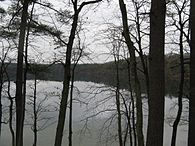

Walden Pond in November - Concord Museum
- Old North Bridge
- The Old Manse, home of Emerson and Hawthorne
- Egg Rock, accessible by water or land
- Ralph Waldo Emerson House
- The Wayside, home of Louisa May Alcott, Hawthorne, and Margaret Sidney
- Orchard House
- Minute Man National Historical Park
- Walden Pond
- Wright's Tavern
- Reuben Brown House, home of notable revolutionist
- Concord Free Public Library
- First Parish Church
- Thoreau Farm, birthplace of Henry David Thoreau
- Massachusetts Correctional Institution – Concord
- Northeastern Correctional Center
- West Concord Supermarket (Mandrioli's)
Education
- Concord Carlisle Regional High School, the local public high school
- Concord Middle School (consisting of two buildings about a mile apart: Sanborn and Peabody)
- Alcott School, Willard School, and Thoreau School, the local public elementary schools
- Concord Academy and Middlesex School, private preparatory schools
- The Fenn School and The Nashoba Brooks School, private primary schools
Transportation
- Commuter rail service to Boston's North Station is provided by the MBTA with two stops in Concord on its Fitchburg Line.
- Yankee Lines provides a commuter bus service to Copley Square in Boston from Concord Center
Notable residents and natives
- Chris Abele, County Executive of Milwaukee County, Wisconsin
- Seth Abramson, poet[33]
- Bronson Alcott, teacher and writer
- Louisa May Alcott, novelist
- Laurie Baker, USA Hockey gold medalist[34]
- Paget Brewster, actress
- Ephraim Bull, inventor of the Concord grape
- Steve Carell, comedian (lived in Acton but attended boarding school at Middlesex)
- Darby Conley, cartoonist
- Patricia Cornwell, contemporary American crime writer and author[35]
- Harrison Gray Dyar, chemist and inventor
- Ralph Waldo Emerson, essayist, poet and philosopher
- Will Eno, author and playwright
- Daniel Chester French, sculptor
- Michael Fucito, MLS player
- John Hoar, redeemer of famed captive Mary Rowlandson during King Philip's War
- Kevin Garnett, NBA player
- Hal Gill, NHL player[36]
- Doris Kearns Goodwin, historian and writer[37]
- Richard N. Goodwin, advisor and speechwriter to Presidents Kennedy and Johnson
- Nathaniel Hawthorne, novelist and short story writer
- Dick Hustvedt, software engineer
- Alan Lightman, physicist, novelist and essayist[38]
- Gregory Maguire, author[39]
- Andrew McMahon, musician and lead singer of Something Corporate and Jack's Mannequin
- Russell Miller, author and historian
- Robert B. Parker, author[40]
- Uta Pippig, marathon runner[41]
- Sam Presti, NBA executive[42]
- Amelia Atwater-Rhodes, novelist
- David Allen Sibley, ornithologist and author
- Margaret Sidney (Harriett Mulford Stone), author
- Henry David Thoreau, author, naturalist and philosopher
- John Tortorella, New York Rangers head coach
- Will Tuttle, author, educator and composer
- Jonas Wheeler, Maine Senate President
- Samuel Willard, 17th century colonial minister
- Gordon S. Wood, historian and author[43]
See also
References
- ^ a b "Concord". Encyclopædia Britannica. http://www.britannica.com/eb/article-9025094/Concord#195620.hook. Retrieved April 9, 2007.
- ^ "Peter Bulkeley: Settlement in Concord". New England Historic Genealogical Society. Archived from the original on September 27, 2007. http://web.archive.org/web/20070927032104/http://www.newenglandancestors.org/education/articles/research/special_guests/member_staff/peter_bulkeley_deacon_and_co_founder_of_concord_m_659_517.asp. Retrieved April 9, 2007.
- ^ Shattuck, Lemuel (1835). "History of the Town of Concord, Mass". RootsWeb. Archived from the original on November 20, 2007. http://web.archive.org/web/20071120161419/http://ftp.rootsweb.com/pub/usgenweb/ma/middlesex/towns/concord/histch01.txt. Retrieved April 9, 2007.
- ^ "Today In History: April 19th". The Library of Congress. http://memory.loc.gov/ammem/today/apr19.html. Retrieved April 3, 2007.
- ^ Randolph, Ryan. Paul Revere and the Minutemen of the American Revolution. The Rosen Publishing Group via Google Books. http://books.google.com/books?id=DItAX0GNQpwC&pg=PT85&lpg=PT85&dq=%22coffin+broadside%22+-jackson#PPT86,M1. Retrieved April 9, 2007.
- ^ Gioia, Dana. ""On "Paul Revere's Ride" by Henry Wadsworth Longfellow"". http://www.danagioia.net/essays/elongfellow.htm. Retrieved April 2, 2007.
- ^ "Featured Resource: Photograph Collection 374". The State Library of Massachusetts. http://www.mass.gov/lib/. Retrieved April 9, 2007.
- ^ "Emerson in Concord". Concord Public Library – Special Collections. http://www.concordlibrary.org/scollect/Emerson_Celebration/Introduction.html. Retrieved April 18, 2007.
- ^ "Emerson's Concord Heritage". Concord Public Library – Special Collections. Archived from the original on February 5, 2007. http://web.archive.org/web/20070205235202/http://www.concordnet.org/library/scollect/Emerson_Celebration/Section_1_Essay.html. Retrieved April 9, 2007.
- ^ "Henry David Thoreau". Massachusetts Department of Conservation and Recreation. http://www.mass.gov/dcr/parks/northeast/wldn.htm. Retrieved April 9, 2007.
- ^ Kehe, Marjorie. "Scenes from an American Eden". The Christian Science Monitor. http://www.csmonitor.com/2006/1219/p14s02-bogn.html. Retrieved March 6, 2007.
- ^ Perry, Bliss. "The American Spirit in Literature: The Transcendentalists". Authorama.com (public domain). http://www.authorama.com/american-spirit-in-literature-6.html. Retrieved April 9, 2007.
- ^ "Thoreau's Walden, Present at the Creation". National Public Radio. http://www.npr.org/programs/morning/features/patc/walden/. Retrieved April 9, 2007.
- ^ McElroy, Wendy. "Henry David Thoreau and 'Civil Disobedience'". The Future of Freedom Foundation. http://www.fff.org/freedom/fd0503e.asp. Retrieved April 9, 2007.
- ^ "The Wayside". National Park Service. http://www.nps.gov/archive/mima/wayside/index1.htm. Retrieved April 9, 2007.
- ^ "The Wayside: History". National Park Service. http://www.nps.gov/archive/mima/wayside/Histfrm1.htm. Retrieved April 9, 2007.
- ^ "The Wayside Authors". National Park Service. http://www.nps.gov/archive/mima/wayside/Marg.htm. Retrieved April 9, 2007.
- ^ Lipman, Lisa. "Writers rest in Sleepy Hollow". The Globe & Mail. http://www.theglobeandmail.com/servlet/story/LAC.20001129.TR29GRAV/TPStory/Travel. Retrieved April 9, 2007.
- ^ "The Concord Grape". National Grape Cooperative. http://www.nationalgrape.com/02b_ccd.shtml. Retrieved April 9, 2007.
- ^ "All About Welch's: General Company Information". Welchs.com. http://www.welchs.com/company/general_co_info.html. Retrieved April 3, 2007.
- ^ "TOTAL POPULATION (P1), 2010 Census Summary File 1, All County Subdivisions within Massachusetts". United States Census Bureau. http://factfinder2.census.gov/bkmk/table/1.0/en/DEC/10_SF1/P1/0400000US25.06000. Retrieved September 13, 2011.
- ^ "Massachusetts by Place and County Subdivision - GCT-T1. Population Estimates". United States Census Bureau. http://factfinder.census.gov/servlet/GCTTable?_bm=y&-geo_id=04000US25&-_box_head_nbr=GCT-T1&-ds_name=PEP_2009_EST&-_lang=en&-format=ST-9&-_sse=on. Retrieved July 12, 2011.
- ^ "1990 Census of Population, General Population Characteristics: Massachusetts". US Census Bureau. December 1990. Table 76: General Characteristics of Persons, Households, and Families: 1990. 1990 CP-1-23. http://www.census.gov/prod/cen1990/cp1/cp-1-23.pdf. Retrieved July 12, 2011.
- ^ "1980 Census of the Population, Number of Inhabitants: Massachusetts". US Census Bureau. December 1981. Table 4. Populations of County Subdivisions: 1960 to 1980. PC80-1-A23. http://www2.census.gov/prod2/decennial/documents/1980a_maABC-01.pdf. Retrieved July 12, 2011.
- ^ "1950 Census of Population". Bureau of the Census. 1952. Section 6, Pages 21-10 and 21-11, Massachusetts Table 6. Population of Counties by Minor Civil Divisions: 1930 to 1950. http://www2.census.gov/prod2/decennial/documents/23761117v1ch06.pdf. Retrieved July 12, 2011.
- ^ "1920 Census of Population". Bureau of the Census. Number of Inhabitants, by Counties and Minor Civil Divisions. Pages 21-5 through 21-7. Massachusetts Table 2. Population of Counties by Minor Civil Divisions: 1920, 1910, and 1920. http://www2.census.gov/prod2/decennial/documents/41084506no553ch2.pdf. Retrieved July 12, 2011.
- ^ "1890 Census of the Population". Department of the Interior, Census Office. Pages 179 through 182. Massachusetts Table 5. Population of States and Territories by Minor Civil Divisions: 1880 and 1890. http://www2.census.gov/prod2/decennial/documents/41084506no553ch2.pdf. Retrieved July 12, 2011.
- ^ "1870 Census of the Population". Department of the Interior, Census Office. 1872. Pages 217 through 220. Table IX. Population of Minor Civil Divisions, &c. Massachusetts. http://www2.census.gov/prod2/decennial/documents/1870e-05.pdf. Retrieved July 12, 2011.
- ^ "1860 Census". Department of the Interior, Census Office. 1864. Pages 220 through 226. State of Massachusetts Table No. 3. Populations of Cities, Towns, &c.. http://www2.census.gov/prod2/decennial/documents/1860a-08.pdf. Retrieved July 12, 2011.
- ^ "1850 Census". Department of the Interior, Census Office. 1854. Pages 338 through 393. Populations of Cities, Towns, &c.. http://www2.census.gov/prod2/decennial/documents/1850c-11.pdf. Retrieved July 12, 2011.
- ^ "American FactFinder". United States Census Bureau. http://factfinder.census.gov. Retrieved 2008-01-31.
- ^ "Concord". The American Heritage Dictionary. http://www.bartleby.com/61/94/C0549400.html. Retrieved April 10, 2007.
- ^ "Seth Abramson, MFA Blog Contributor". creative-writing-mfa-handbook.blogspot.com. http://creative-writing-mfa-handbook.blogspot.com/2007/07/seth-abramson-mfa-blog-contributor.html. Retrieved June 15, 2010.
- ^ "United States Olympic Committee – Baker, Laurie". USOC.org. Archived from the original on July 14, 2007. http://web.archive.org/web/20070714080043/http://www.usoc.org/26_1160.htm. Retrieved August 13, 2007.
- ^ Cornwell, Patricia (December 3, 2008). "Crime pays quite well for Patricia Cornwell". USAToday.com. http://www.usatoday.com/life/books/news/2008-12-01-patricia-cornwell_N.htm. Retrieved 2008.
- ^ "Hal Gill". ESPN.com. http://sports.espn.go.com/nhl/players/profile?statsId=1661. Retrieved April 9, 2007.
- ^ Lamb, Brian. "Booknotes: No Ordinary Time". CSPAN.com. http://www.booknotes.org/Transcript/?ProgramID=1232. Retrieved April 3, 2007.
- ^ http://www.mit.edu/~humanistic/faculty/lightman.html
- ^ "Gregory Maguire". HoughtonMifflinBooks.com. http://www.houghtonmifflinbooks.com/catalog/authordetail.cfm?authorID=2334. Retrieved August 13, 2007.
- ^ Kifner, John. "He Said He Had a Pistol; Then He Flashed a Knife". New York Times. http://www.nytimes.com/books/01/03/25/specials/parker-interview97.html?_r=1&oref=slogin. Retrieved April 3, 2007.
- ^ English, Bella (November 3, 2004). "She's home, for the long run". Boston Globe. http://www.boston.com/ae/celebrity/articles/2004/11/03/shes_home_for_the_long_run/. Retrieved June 25, 2007.
- ^ "SONICS: Presti Named Sonics General Manager". NBA.com. http://www.nba.com/sonics/news/presti070607.html. Retrieved December 24, 2007.
- ^ "Providence College: 2007 Honorary Degree Citations". Providence.edu. http://www.providence.edu/About+PC/College+News/Hidden+Press+Kit+Items/2007+Honorary+Degree+Citations.htm. Retrieved August 30, 2007.
Further reading
- 1871 Atlas of Massachusetts. by Wall & Gray. Map of Massachusetts. Map of Middlesex County.
- History of Middlesex County, Massachusetts, Volume 1 (A-H), Volume 2 (L-W) compiled by Samuel Adams Drake, published 1879-1880. 572 and 505 pages. Concord article by Rev. Grindall Reynolds in volume 1 pages 380-405.
External links
- Town of Concord, MA Official Town Government Website
- Concord Public School System Official Website (includes Concord-Carlisle district)
- Concord Chamber of Commerce
- The Concord Life A Concord blogsite for the visitor. Also a Travel Book published in 2009.
- MCI-Concord overview of Massachusetts Correctional Institution – Concord
- Concord’s African American & Abolitionist History Map from the Drinking Gourd Project
- Concord (Massachusetts) travel guide from Wikitravel
Municipalities and communities of Middlesex County, Massachusetts Cities Towns Acton | Arlington | Ashby | Ashland | Ayer | Bedford | Belmont | Billerica | Boxborough | Burlington | Carlisle | Chelmsford | Concord | Dracut | Dunstable | Framingham | Groton | Holliston | Hopkinton | Hudson | Lexington | Lincoln | Littleton | Maynard | Natick | North Reading | Pepperell | Reading | Sherborn | Shirley | Stoneham | Stow | Sudbury | Tewksbury | Townsend | Tyngsborough | Wakefield | Wayland | Westford | Weston | Wilmington | Winchester
CDPs Ayer | Cochituate | Fort Devens | East Pepperell | Groton | Hopkinton | Hudson | Littleton Common | Pepperell | Pinehurst | Shirley | Townsend | West Concord
Other
villagesAuburndale | Chestnut Hill | Gleasondale | Newton Centre | Newton Highlands | Newton Lower Falls | Newton Upper Falls | Newtonville | Nonantum | North Billerica | North Chelmsford | Waban | West Newton
Categories:- Concord, Massachusetts
- Towns in Middlesex County, Massachusetts
- Populated places established in 1635
- Transcendentalism
- Towns in Massachusetts
Wikimedia Foundation. 2010.


